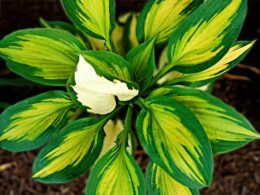You love spending time in your garden, but you want to make sure that it always looks beautiful and colorful. You’re looking for a shrub that can provide you with a pop of color and blooms all summer long.
Luckily, there are several options to choose from that can give your garden the vibrant look you crave. Hydrangea, crape myrtle, rose of Sharon, abelia, and butterfly bush are all shrubs that can bloom for an extended period. Each one has its unique characteristics and requirements, but they’re all easy to care for and can provide you with a long-lasting burst of color.
In this article, we’ll explore each of these shrubs and help you decide which one is the best fit for your garden. So, let’s get started!
Hydrangea
You’ll love the beautiful blooms that the Hydrangea has to offer throughout the entire summer season. This popular shrub produces large, colorful flowers in shades of blue, pink, white, and purple.
Hydrangeas are perfect for adding color and interest to your landscape, and they’re also great for making beautiful Hydrangea arrangements to brighten up your home.
To keep your Hydrangea blooming all summer long, it’s important to follow some simple pruning tips. First, make sure to prune your Hydrangea in the spring, before new growth appears. Cut back any dead or damaged branches, as well as any old wood that isn’t producing new growth. This will encourage the plant to produce more blooms and keep it looking healthy and vibrant.
Incorporate a Hydrangea into your landscape and enjoy the beautiful blooms all summer long. With a little pruning and care, your Hydrangea will thrive and add color to your home and garden.
And don’t forget to try making some stunning Hydrangea arrangements to show off your beautiful blooms!
Crape Myrtle
If you’re looking for a plant with a long blooming season, you should consider the crape myrtle. These shrubs come in a variety of colors and sizes, so you can find one that fits your landscaping needs. Plus, crape myrtles can be grown as either a tree or a shrub, giving you even more flexibility.
Adjust the paragraph structure in the Input to logically group complete sentences on their own lines, with a double new line after. Use contractions.
Long Blooming Season
You can enjoy vibrant blooms for an extended period of time with this plant, making it a great addition to any garden. The long blooming season of certain shrubs can be a real benefit, as it means you can enjoy the beauty of their flowers for weeks or even months on end.
Here are some tips for maintaining long blooming shrubs and making sure they continue to flourish:
-
Keep the soil moist: Shrubs with long blooming seasons need plenty of water to keep their flowers looking their best. Make sure the soil around the plant is consistently moist, but not soaking wet.
-
Fertilize regularly: Long blooming shrubs need plenty of nutrients to support their extended blooming periods. Fertilize them regularly with a balanced fertilizer to help them stay healthy and strong.
-
Deadhead spent blooms: To encourage your shrub to keep producing new flowers, it’s important to remove any spent blooms. This will also help to keep the plant looking neat and tidy.
-
Prune as needed: Some long blooming shrubs can get quite large, so it’s important to prune them as needed to keep them under control and encourage new growth. Be sure to research the specific pruning needs of your plant to avoid damaging it.
Variety of Colors and Sizes
With its wide range of colors and sizes, you can easily find a long blooming shrub that perfectly complements your garden and adds a pop of color and texture. From small, compact shrubs to tall, sprawling ones, there is a shrub to fit any gardening style. Some popular choices include the butterfly bush, which attracts pollinators and comes in shades of purple, pink, and white, and the hydrangea, which offers large, showy blooms in blue, pink, or white.
When planting your long blooming shrub, make sure to choose a spot with well-draining soil and plenty of sunlight. Water consistently and avoid over-fertilizing, as this can lead to excessive growth and fewer blooms. Regular pruning can help maintain the shape and health of your shrub, but be sure to research specific maintenance techniques for your chosen variety. With proper care, your long blooming shrub will be a stunning addition to your garden for years to come.
Can Be Grown as a Tree or Shrub
The long blooming shrub can transform into a majestic tree, standing tall and proud in your garden. One of the most remarkable things about this shrub is that it can be grown as both a tree and a shrub, giving you the flexibility to choose which one suits your garden best.
Growing it as a tree can add a stunning focal point to your landscape, while growing it as a shrub can help fill in empty spaces in your garden. However, there are pros and cons to growing it as both a tree and a shrub.
Growing it as a tree requires more space and maintenance, but it can also provide more shade and a larger area of blooming flowers. On the other hand, growing it as a shrub requires less space, maintenance, and pruning, but it may not provide as much shade or blooming flowers.
Regardless of how you choose to grow it, the best pruning techniques involve removing any dead or diseased branches and shaping it as desired to maintain its beauty and health.
Rose of Sharon
You’ll love the Rose of Sharon for its stunning blooms that grace your garden throughout the entire summer season. This flowering shrub is easy to grow and maintain, making it a perfect choice for those who want a hassle-free garden.
It can be planted in a variety of soil types, but it prefers well-draining soil that is slightly acidic. To keep your Rose of Sharon looking its best, you need to prune it regularly. This shrub can grow up to 12 feet tall, but you can control its height by pruning it back in the early spring. You can also remove any dead or damaged branches to promote new growth.
When planting your Rose of Sharon, make sure to choose a location that receives full sun to encourage the most blooms. The Rose of Sharon is a great addition to any garden, as it not only adds beauty but also attracts pollinators like butterflies and bees. It’s also drought tolerant, making it a perfect choice for those who live in areas with hot summers.
With its stunning blooms and easy maintenance, the Rose of Sharon is a must-have for any garden enthusiast.
Abelia
If you’re looking for a low-maintenance addition to your garden that adds a pop of color and attracts hummingbirds, try planting Abelia shrubs. These flowering shrubs are known for their long-lasting blooms, which can last from spring all the way through to fall. They come in a variety of colors, including pink, white, and red, and are a great way to add a splash of color to your landscape.
One of the best things about Abelia shrubs is that they require very little maintenance. They don’t need to be pruned very often, and they are resistant to most pests and diseases. However, if you do need to prune them, it’s best to do so in the fall or winter, after they have finished blooming. This will help to promote new growth and ensure that your shrubs stay healthy and vibrant.
Abelia shrubs also make great companion plants for other species, such as roses, hydrangeas, and azaleas. They are versatile enough to be planted in full sun or partial shade, and they can grow up to six feet tall, making them a great choice for a privacy screen or hedge.
So if you’re looking for a hardy shrub that will add beauty and color to your garden all summer long, consider planting Abelia.
Butterfly Bush
Get ready to attract a flurry of butterflies to your garden with the low-maintenance and colorful butterfly bush! This shrub is a true showstopper with its vibrant flowers that bloom all summer long. The butterfly bush is easy to grow and maintain, making it an excellent choice for gardeners of all levels.
To grow a healthy butterfly bush, make sure to plant it in well-draining soil that receives plenty of sunlight. Water the shrub regularly, but avoid overwatering as this can lead to root rot. Prune the butterfly bush in the late winter or early spring to encourage new growth and remove any dead or damaged branches.
Not only is the butterfly bush beautiful to look at, but it also benefits pollinators such as butterflies, bees, and hummingbirds. By planting this shrub in your garden, you’re providing a valuable food source for these important creatures.
So, go ahead and add the butterfly bush to your garden today and enjoy the beauty and benefits it has to offer!
Frequently Asked Questions
How do I properly prune and maintain these shrubs?
To properly prune and maintain shrubs, it’s important to know the best pruning techniques and time to prune. Pruning is necessary to keep shrubs healthy and promote new growth.
You can begin by removing any dead or diseased branches, then cut back any overgrown branches to maintain the shape of the shrub.
Propagation methods include taking cuttings from the shrub and planting them in soil or water until they develop roots.
Repotting tips include using a well-draining soil mix and ensuring the shrub has enough space to grow.
By following these techniques and tips, you can ensure your shrubs remain healthy and vibrant all season long.
Which shrub is the most suitable for a small garden or container planting?
If you’re looking to start a container garden or have limited space in your small garden, there are several shrubs that will thrive in these conditions. Before planting, make sure to prepare your soil by adding compost and ensuring proper drainage.
One great option for a container garden is the dwarf Korean lilac, which produces fragrant blooms in the spring and is easy to maintain.
Another option is the boxwood, which is evergreen and can be pruned into various shapes.
For a pop of color, consider the butterfly bush, which attracts pollinators and blooms from summer to fall.
No matter which shrub you choose, make sure to choose the right container and provide adequate water and sunlight.
Can these shrubs tolerate full sun or do they require partial shade?
If you’re looking to plant shrubs in your garden, it’s important to understand their sun exposure and soil requirements. Some shrubs can tolerate full sun exposure while others require partial shade.
It’s best to research the specific shrub you’re interested in and determine what its needs are. Additionally, different shrubs thrive in different types of soils, so it’s important to consider the soil quality in your garden before planting.
Keep in mind that proper care and maintenance, including regular watering and pruning, can help your shrubs flourish regardless of their sun exposure and soil requirements.
Are there any insect or disease issues that commonly affect these shrubs?
When it comes to insect and disease issues that commonly affect shrubs, prevention is key. There are several prevention methods that you can use to keep your shrubs healthy and disease-free.
One of the best prevention methods is to keep your shrubs well-watered and well-fed. This will help to keep them strong and healthy, making them less susceptible to disease.
Additionally, there are many natural remedies that can be used to treat common insect and disease issues. For example, spraying your shrubs with a mixture of water and dish soap can help to ward off aphids and other pests. You can also use a mixture of baking soda and water to treat fungal infections.
By taking proactive steps to prevent insect and disease issues, and using natural remedies when necessary, you can help to ensure that your shrubs remain healthy and vibrant all season long.
What is the average lifespan of these shrubs and do they require regular fertilization?
If you’re planning on adding shrubs to your garden, it’s important to know their average lifespan and fertilization requirements. Most shrubs have a lifespan of around 10-20 years, but this can vary depending on the species and growing conditions.
To ensure your shrubs live a healthy and long life, it’s important to fertilize them regularly with a balanced fertilizer. This will provide the necessary nutrients for growth and help prevent disease and insect issues. Keep in mind that over-fertilization can also be harmful, so be sure to follow the recommended dosage on the fertilizer package.
By taking care of your shrubs, you’ll be able to enjoy their beauty and benefits for years to come.
Conclusion
So, you’re looking for a shrub that blooms all summer long? Well, you’ve got a few great options to choose from.
Hydrangeas are a popular choice with their large, showy blooms. Crape myrtles are also a great option, with their long-lasting flowers in shades of pink, purple, and white.
Rose of Sharon is another shrub that blooms all summer, with its pretty, hibiscus-like flowers in shades of pink, blue, and white. Abelia is a lesser-known shrub that is worth considering, with its delicate, bell-shaped flowers that come in shades of pink, white, and red.
And last but not least, the butterfly bush is a favorite of many gardeners, with its fragrant, colorful flowers that attract butterflies and other pollinators all summer long.
No matter which shrub you choose, be sure to provide it with the right growing conditions, including plenty of sun, well-draining soil, and regular watering. With a little care and attention, you’ll be rewarded with a beautiful, blooming shrub that will bring color and life to your garden all summer long.
So, go ahead, pick your favorite and get planting!








